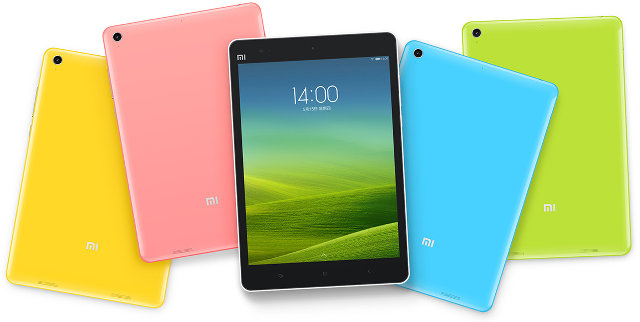Xiaomi Mi Pad 7.9″ tablet powered by Nvidia Tegra K1 processor was launched in 2014 with either 16 or 64 GB flash, and on July on that year you could buy the version with 64GB storage would sell for $370 and up from sites like Aliexpress. A little over two years, the price has dramatically dropped, and there’s now a promotion for Xiaomi Mi Pad with 64GB storage for $119.99 on GearBest with MiPad64G or MP64GBCSMO coupon.
 Let’s refresh our memory with the specifications of the tablet:
Let’s refresh our memory with the specifications of the tablet:
- SoC – Nvidia Tegra K1 quad core Cortex A15 processor @ 2.2 GHz with Nvidia 192-core Kepler GPU
- System Memory – 2GB LPDDR3
- Storage – 64GB eMMC, extensible to 128GB via microSD card
- Display – 7.9” IPS display, 2048×1536 resolution; 326 PPI
- Camera – 8MP rear camera, 5MP front-facing camera
- Connectivity – 802.11ac 2×2 Wi-Fi, Bluetooth 4.0
- Audio – 3.5mm audio jack, speaker
- USB – 1x micro USB port
- Battery – 6700 mAh battery
- Dimensions – 202.1 x 135.4 x 8.5 mm
- Weight – 360 grams
Even by today’s standards, XiaoMi Mi Pad should offer a pretty good performance, but the main downside is the tablet is stuck with Android MIUI V5 operating system based on Android 4.4. English is supported by default, but some other languages such as German, Italian and Dutch, are not supported in the firmware, however GearBest claims they can “offer these language packs”.
Via AndroidPC.es

Jean-Luc started CNX Software in 2010 as a part-time endeavor, before quitting his job as a software engineering manager, and starting to write daily news, and reviews full time later in 2011.
Support CNX Software! Donate via cryptocurrencies, become a Patron on Patreon, or purchase goods on Amazon or Aliexpress





It’s supported by xiaomi.eu roms (MIUI 8 on Android 4.4). Despite being stuck on KitKat, it is still great tablet and definitely worth the price.
My one is still running strong I love it. It is the best tablet I ever came across.
AFAIK there is still no kernel source (i.e. GPL violation) for this device…
@ade
You’re right. There’s a comment fest @ https://github.com/MiCode/Xiaomi_Kernel_OpenSource/issues/18#issuecomment-106164583
@cnxsoft
I wonder whether it might be feasible to use kernel from NViDIA Shield Tablet, together with Mipad’s DTB ?
Is Mipad’s bootloader locked ?
A great option, if only we had more synergy between Linux and Android distros.
@cnxsoft
So why is CNX Software promoting the sale of a product for which the manufacturer contravenes the GPL and refuses to release the source code?
Hear hear!
@Lieutenant Colonel Olivier South
1. It’s cheap, 2. It’s fast 3. I was not aware about the GPL violation at the time.
On top of that checking whether devices comply with licenses and laws takes a lot of time or money, and if I only wrote about fully “clean” devices on that blog it would be mostly empty, and most probably not exist at all.
@Lieutenant Colonel Olivier South
There’s a lot of people culpable in varying degrees for the GPL mess around Android (and Linux generally)… I don’t think @cnxsoft is at the core of the problem!
Personally I buy these things because they’re cheap and functional, and soothe my conscience by contributing to open source software as I’m able to. And I appreciate @cnxsoft telling me about them 🙂
Also personally, I believe that the biggest step in improving the situation could be taken by Google, by making GPL compliance a condition of using the Android trademark. I can’t imagine how that would affect the number of Android devices getting to market, but I don’t think it would be all that serious. Might give the Chinese manufacturers something to think about?
I bought one when it came out. But even after two years there still aren’t many apps optimized for Mi Pad.
@RobBrownNZ
Google does not like the GPL, otherwise they would not have rewritten everything under liberal licences, except the linux kernel (probably too big to rewrite).
I agree, I am not certain that any 100% open system exists. Where do you draw the line? Should we get source for the controllers inside the eMMC chip and the disk drives? Source for the controller in the keyboard, mouse?
Source for K1 kernel is supposed to be here:
https://developer.nvidia.com/embedded/develop/tools
I have not worked with it.
@zoobab
It was Google’s customers, not Google, that forced the GPL code out of user space. Those customer demands caused a lot of pain for Google such as making them have to pointlessly write an entire Bluetooth stack again (that’s why Apple had BT two years earlier).
These customers want to install closed, proprietary apps. There want to be certain that those app do not get inadvertently tainted by user space GPL pieces.
NVidia has a full Android Marshmallow build repo for the Shield K1 tablet at https://developer.nvidia.com/shield-open-source. I’m sure it will be “relatively straightforward” to adapt that for the Mi Pad. I’ll probably have a go at it, but I’ve tried multiple times to port Android to different devices and always got lost in the maze.